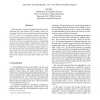Free Online Productivity Tools
i2Speak
i2Symbol
i2OCR
iTex2Img
iWeb2Print
iWeb2Shot
i2Type
iPdf2Split
iPdf2Merge
i2Bopomofo
i2Arabic
i2Style
i2Image
i2PDF
iLatex2Rtf
Sci2ools
IPPS
2007
IEEE
2007
IEEE
Average Execution Time Analysis of a Self-stabilizing Leader Election Algorithm
This paper deals with the self-stabilizing leader election algorithm of Xu and Srimani [10] that finds a leader in a tree graph. The worst case execution time for this algorithm is O(N4 ), where N is the number of nodes in the tree. We show that the average execution time for this algorithm, assuming two different scenarios, is much lower than O(N4 ). In the first scenario, the algorithm assumes a equiprobable daemon and it only privileges a single node at a time. The average execution time for this case is O(N2 ). For the second case, the algorithm can privilege multiple nodes at a time. We eliminate the daemon from this algorithm by making random choices to avoid interference between neighbor nodes. The execution time for this case is O(N). We also show that for specific tree graphs, these results reduce even more.
Algorithm | Average Execution Time | Distributed And Parallel Computing | Execution Time | IPPS 2007 |
| Added | 03 Jun 2010 |
| Updated | 03 Jun 2010 |
| Type | Conference |
| Year | 2007 |
| Where | IPPS |
| Authors | Juan Paulo Alvarado-Magaña, José Alberto Fernández-Zepeda |
Comments (0)

